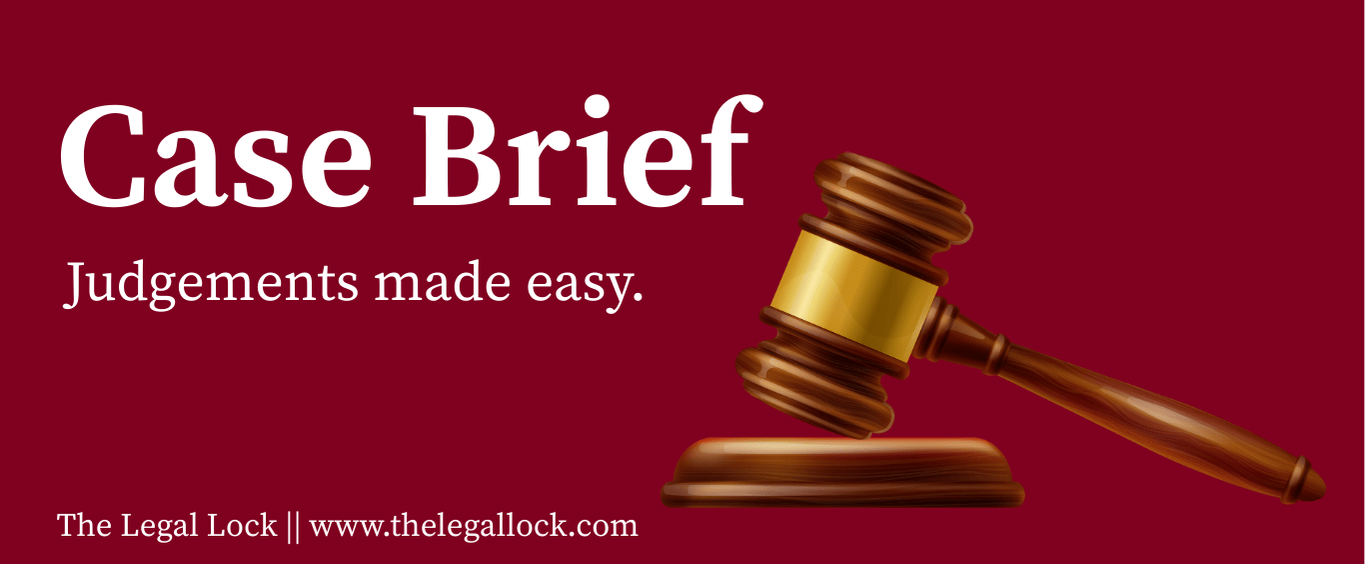Case Brief: Rajendra Kumar Shrivas v. State of Madhya Pradesh and Ors.

| Case Name | Rajendra Kumar Shrivas v. State of Madhya Pradesh And Ors. |
| Citation | (2023) 5 SCC 3642023 LiveLaw (SC)181 |
| Court | The Supreme Court of India |
| Bench | Justice M. R. ShahJustice C.T. Ravikumar |
| Decided on | March 13th, 2023 |
| Case No. | Civil Appeal No. 1514 of 2023 |
INTRODUCTION
A hidden but essential war is taking place in the sacred halls of Indian justice, where the scales of fairness are expected to be perfectly balanced. This struggle does not entail courtroom scenes or passionate legal discussions but rather painstaking computations and challenged interpretations of quotas, as evidenced in a recent case from Madhya Pradesh’s High Court.
The difficult balance between promoting experienced judicial officials from inside the system and instilling new talent through competitive tests is at the heart of the issue. This dance is guided by complex quotas, notably the 10% set aside for “Limited Departmental Competitive Examinations” (LDCEs).
Consider a chessboard with promotions and external recruiting as competing players fighting for strategic control. The LDCE quota serves as a specialized pawn on this board, precisely placed to ensure balance. But what happens when this piece moves beyond its allocated square, tipping the balance in one direction?
This is the essence of the Madhya Pradesh case. The dissatisfied petitioners, who are experienced judicial officers, claim that the High Court exceeded the 10% LDCE quota for Higher Judicial Service (HJS) appointments, tipping the scales unjustly towards foreign recruitment. Their charges reverberate through the corridors of power, raising concerns about fairness, transparency, and the entire premise of meritocratic advancement in the court.
This issue goes beyond individual disputes; it reflects a greater systemic concern about maintaining the delicate balance within the Indian legal system. It’s a narrative of quotas and contentious interpretations, internal goals vs external competition, and, finally, the desire of a fair and efficient court that serves everyone. As legal experts examine the arguments and assess the evidence, the destiny of innumerable dreams sits in the balance, waiting for the scales of justice to shift in favour of a brighter future for the Indian court.
FACTS OF THE CASE
- The case involves promotions within the Madhya Pradesh Higher Judicial Service under the Madhya Pradesh Higher Judicial Service (Recruitment and Conditions of Service) Rules, 1994.
- The Rules specify two categories for promotions: 50% based on merit-cum-seniority and suitability test from Civil Judges (Senior Division), and 25% through promotion based on merit via a limited competitive examination.
- The petitioners argue that a Supreme Court judgment necessitates reading the 25% allocation as 10%, challenging the interpretation of the rules in this context.
- According to the petitioners, only 10% of the promotions should be filled through the limited competitive examination, and any excess appointments would be in violation of the Supreme Court judgment and the statutory rules.
- An advertisement for 11 posts under Rule 5(1)(b) of the Rules has been issued, prompting the petitioners to claim that this, coupled with previous appointments, would exceed the permissible limit of 10% for promotions through the limited competitive examination.
- The core contention is that the appointments made and those proposed in the advertisement collectively surpass the defined quota, leading to a violation of both the Supreme Court judgment and the statutory rules.
- The case revolves around the complex interplay of legal interpretations, quota allocations, and procedural intricacies in the context of promotions within the judicial hierarchy.
- The resolution of the case carries implications not only for the specific appointments in question but also for the broader understanding and application of rules governing promotions within the Madhya Pradesh Higher Judicial Service.
ISSUES
- Whether the High Court’s ruling will be overturned, and may appointments be made in excess of the 10% quota?
ARGUMENTS
Petitioners:
- The MPHC choices breached the Supreme Court’s 10% LDCE guideline, resulting in unfair internal promotions.
- Failure to alter rules jeopardized transparency and consistency.
- Petitioners have a legal interest in guaranteeing fair promotion procedures in the judiciary, even if they don’t benefit immediately.
Respondents:
- The petitioners lacked the essential locus standi due to their retired or suspended status.
- Challenging already filled appointments was impractical and outside the scope of writ petitions.
- The MPHC acknowledged certain quota overshoots but said they were inadvertent and corrected in later recruitments.
ANALYSIS
The crux of the case is a complex reading of the Madhya Pradesh Higher Judicial Service Rules, 1994, notably in the context of promotions through restricted competitive examination. Based on a Supreme Court decision, the petitioners argue that the 25% quota specified in the guidelines should be construed as 10%. This legal issue is the foundation of their case, adding a layer of complication to the interpretation of statutory requirements.
The evaluation of the type of appointments made that apparently exceed the allowed quota is crucial to the study. The court must decide whether such nominations render the appointees ineligible for their posts or if the claimed excess is only a procedural anomaly. This necessitates a comprehensive examination of the regulations and the exact situations under which promotions are permitted.
In addition to the quantitative argument, the court evaluates the appointments’ procedural features. This includes determining whether the appointments strictly followed the legislative regulations, including the criterion for merit, seniority, and the findings of any suitability examinations. This broad investigation intends to uncover numeric abnormalities and any procedural failures in the appointment process.
The petitioners’ concern about the number of advertised openings in proportion to the sanctioned strength of the Higher Judicial Service complicates matters further. This raises questions regarding staff planning, resource allocation within the legal system, and larger administrative problems.
The status of the petitioners to seek a writ of quo warranto against the appointees is important to the court’s conclusion. The court must decide whether the petitioners are real stakeholders acting in the public interest or if their motivations stem from personal grievances. The concept of “clean hands” becomes crucial as the court navigates the tangled web of legal and human elements.
JUDGMENT
The Supreme Court presided over by Justice M R. Shah and Justice C.T. Ravikumar, issued a decision emphasizing the importance of the Madhya Pradesh High Court adhering to the standards established by the highest court in the matter of the All-India Judges Association. The Supreme Court’s instruction in the aforementioned case compelled the reserving of 10% of seats in the upper courts through restricted departmental competitive exams.
The court established that there had been a violation in the purchase of seats earmarked for the departmental competitive examination, citing instances of noncompliance beyond the stated date of 01/01/2011. This violation means that the Madhya Pradesh High Court did not follow the mandated 10% quota for such appointments, contrary to the Supreme Court’s clear directions.
As a remedy, the Supreme Court ruled that all positions that exceeded the 10% limit, particularly those filled in contravention of the specified quota after January 1, 2011, be corrected in future hirings. This change means that appointments made in excess of the statutory 10% quota will be deemed invalid, and remedial procedures will be implemented in the following recruiting processes to bring the judiciary’s composition into conformity with the court’s directions.
The decision reaffirms the Court’s commitment to maintaining previous directions and guaranteeing conformity with the legal framework. It also acts as a disincentive to non-compliance with court rulings, emphasizing the need to adhere strictly to the set norms and quotas in matters of recruiting within the judiciary. The Supreme Court’s forward-thinking method of correcting surplus appointments in future recruitments demonstrates a realistic and cautious effort to immediately correct the breach without disrupting the administration of justice.
CONCLUSION
The Madhya Pradesh tragedy has India’s legal system. The Supreme Court’s ruling has addressed quota violations and promoted openness, but the fundamental issues persist. Can legal declarations ensure impartiality in judicial promotions? Or would more extensive modifications be required to overcome potential gaps and administrative vulnerabilities? The MPHC is now responsible for maintaining the 10% LDCE quota through technological modifications and promoting a culture of compliance and accountability.
The issue also has implications for judicial selections in India as a whole. The issue of locus standi remains unsettled, raising the possibility of future challenges from stakeholders who contest appointments that provide no immediate personal advantage. The topic of whether those who are not immediately impacted by promotions should have a role in building a fair and diverse court ought to be discussed openly.
The Madhya Pradesh case highlights the ongoing debate regarding diversity and representation in Indian courts. The 10% LDCE mandate is designed to promote internal growth and experience, however it does not adequately address the concerns of underrepresented groups in the legal system. To establish a court that accurately represents Indian society’s diverse realities, this challenging problem requires additional thought and, maybe, a reassessment of current quotas and recruiting techniques.






